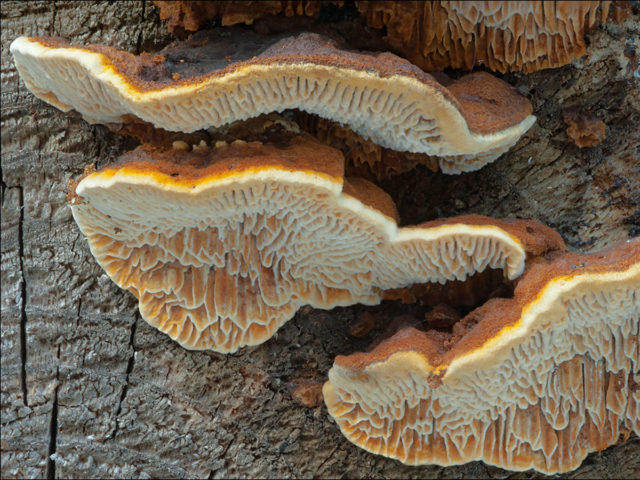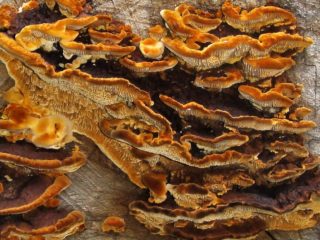Content
Gleophyllum fragrant is a perennial mushroom belonging to the Gleophyllaceae family. Characterized by the large size of the fruiting body. Can grow singly or in small groups. The configuration and size of different representatives may differ, but a characteristic feature of this species is a pleasant anise smell. In official mycological reference books it is listed as Gloeophyllum odoratum.
What does odorous gleophyllum look like?
The shape of the fruiting body of this species is non-standard. It consists only of a cap, the size of which in adult specimens can reach 16 cm in diameter. If they grow in small groups, mushrooms can grow together. Their shape can be hoof-shaped or cushion-shaped, often with various growths on the surface.
In young specimens, the cap feels like felt, but during the process of many years of growth it becomes significantly coarser and becomes rougher. Often small bumps appear on it. The color of the fruiting body varies from yellow-cream to dark ocher. At the same time, the edge of the cap is bright red, blunt, thick, and rounded.
When broken, you can see pulp with a cork consistency. It exudes an aniseed smell, which is why the mushroom got its name. The thickness of the pulp is 3.5 cm, and its color is reddish-brown.
The hymenophore of the fragrant gleophyllum is porous, yellow-brown in color. But with age it noticeably darkens. Its thickness is 1.5 cm. The pores can be round or elongated, angular.
The spores of this species are ellipsoidal, oblique or pointed on one side. Their size is 6-8(9) X 3.5-5 microns.

Gleophyllum fragrant grows tightly to the substrate with a wide base
Where and how does it grow
Gleophyllum fragrant is a common species that grows everywhere. Since it is perennial, it can be seen at any time of the year. Prefers to grow on dead wood and old stumps of coniferous trees, mainly spruce. Sometimes it can be seen on treated wood.
Main places of growth:
- central part of Russia;
- Siberia;
- Ural;
- Far East;
- North America;
- Europe;
- Asia.
Is the mushroom edible or not?
This species belongs to the category of inedible. It cannot be eaten in any form.
Doubles and their differences
Gleophyllum fragrant is in many ways similar in appearance to other representatives of its family. But at the same time, each of them has certain differences.
Existing twins:
- Gleophyllum logum. The cap of this species is rough, its diameter does not exceed 8-10 cm. The color of the fruiting body is gray-brown, and subsequently becomes completely brown. The pulp is thin, leathery, odorless. Its shade is brown-red. Settles on stumps and dead wood of aspen, oak, elm, and less often pine needles. It also causes the development of gray mold like odorous gleophyllum. Refers to inedible mushrooms. The official name is Gloeophyllum trabeum.
Gleophyllum logum is found on all continents except Antarctica
- Gleophyllum oblong. This double has a narrow, triangular-shaped cap. Its size varies between 10-12 cm. The surface is smooth, sometimes cracks may appear. The edges of the cap are wavy. The color of the fruiting body is gray-ocher. This lookalike is inedible. The official name of the mushroom is Gloeophyllum protractum.
The cap of Gleophyllum oblongata has the ability to bend well
Conclusion
Gleophyllum fragrant is of no interest to mushroom pickers. However, its properties are carefully studied by mycologists. The position of this species has not yet been determined. Recent molecular studies have shown that the Gleophyllaceae family is similar to the genus Trametes.










